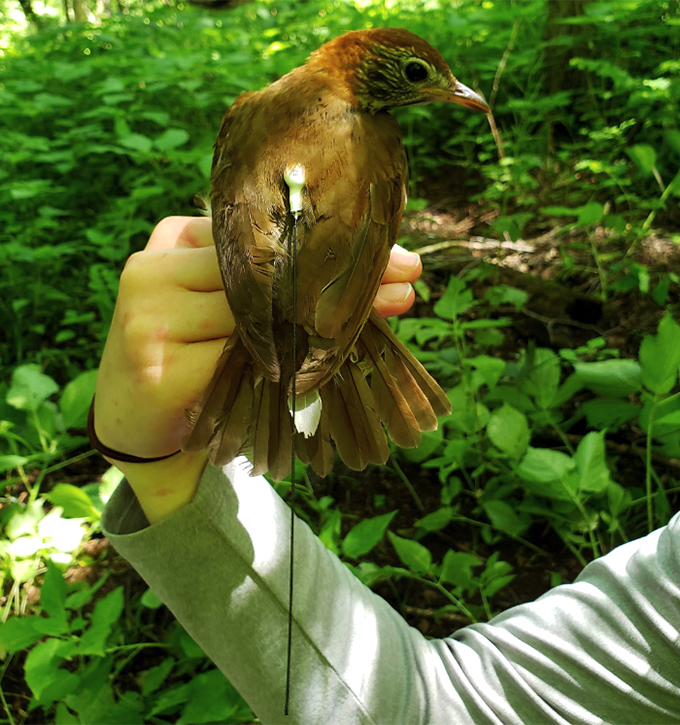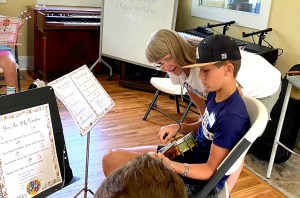Alabama’s WFF expanding Motus Wildlife Tracking network
Published 3:07 pm Thursday, March 27, 2025

- This wood thrush was outfitted with a Motus tag to study migration patterns and habitat preferences. Photo courtesy Iowa DNR
Modern technology is aiding wildlife biologists and researchers in numerous ways, including a tool that is in its infancy in Alabama. The Motus Wildlife Tracking System program erects tracking stations throughout the Americas, Canada, Europe and Australia to detect wildlife (mainly bird) movements, according to Mercedes Maddox, Nongame Wildlife Biologist with the Alabama Department of Conservation and Natural Resources’ (ADCNR) Wildlife and Freshwater Fisheries (WFF) Division.
Motus is a global network of telemetry with antennas that detect unique radio tags, which have been miniaturized to the point where some can even be attached to insects.
“These radio tags can be put on very small birds, like songbirds,” Maddox said. “They even have some for hummingbirds, all the way down to even dragonflies and Monarch butterflies. They allow us to track the migration and stopovers of these migratory animals at a much, much smaller scale than we used to be able to. Typically, the tracking devices were put on the bigger birds like eagles and other raptors, for instance. It was very difficult to track the smaller animals.”
Trending
Maddox said attaching tags to these animals is great, but the effort is wasted if they aren’t detected by one of the tracking stations.
“Alabama just started getting involved in the network, and we now have seven tracking stations,” she said. “Two years ago, we had zero, so there has been a large jump in getting the stations up in Alabama.”
The stations in Alabama are located in the northeast region of the state and the Gulf Coast. Those locations on the coast are at Weeks Bay and Dauphin Island. Locations in northeast Alabama include Cheaha State Park, Cherokee Rock Village, Lake Guntersville State Park, Monte Sano State Park and Paint Rock Forest Research Station. Four of those were installed just four months ago, so it will take some time before enough data accumulates to detect any trends, according to Maddox.
She said more than 2,000 stations are in the network around the world.
“Collaboration is a huge part of the program,” she said. “Someone can put a tag on a bird in Maine, and if it passes within10 to 15 kilometers (6-9 miles) of one of our stations, we’ll get that data, and the person who attached that tag will get that data. It’s a huge collaborative effort, which is one of the really cool things about it.
From one of the Motus stations, a white pelican tagged in Bear River, Utah, was detected in Baldwin County five months later. A wood thrush tagged just south of Toronto, Canada, was detected on the Alabama Gulf Coast five months later.
Trending
Maddox said the Paint Rock station picked up signals from a wood thrush tagged in Illinois, a wood thrush tagged in Kentucky and an Eastern whippoorwill that migrated from Maine.
“Maine is the really cool one to me, to think that bird flew all the way from Maine and flew within detection distance of our Motus station,” she said. “That’s just one of the things we’re learning is how far they migrate and how important habitat is for the birds migrating these really long distances.”
Maddox said previously tags were attached during the breeding season and wintering season, but the work is now focusing on migration.
A program under the direction of the U.S. Fish and Wildlife Service will take place this summer with the goal of tagging wood thrush in each state in its breeding range from Alabama through Illinois and east through Virginia. Each state will get 15 to 25 wood thrush tags.
“We are participating this year, and we will be putting out 16 wood thrush tags to look at migration routes,” Maddox said. “This overall project has partnered with Latin America to get a really big picture of wood thrush.”
To catch wood thrush for tagging, the team will utilize the bird’s innate tendency to protect their territory. A mesh net is erected and a recording of calls made by wood thrush during the early breeding season is played.
“They’re so territorial that they’ll get interested and swoop down to where the noise is coming from, and we will catch them in the net,” Maddox said.
A long-term banding program on Fort Morgan at the Bon Secour National Wildlife Refuge has the potential to be a partner in attaching Motus tags. Maddox is working with Lianne Koczur of the Alabama Audubon Society to potentially attach Motus tags during the spring 2026 migration.
“We don’t really have enough data because we’re very, very early in this program,” Maddox said. “In five to 10 years, I think we will have a wealth of information. I know there are more than 900 projects going on that utilize either Motus tags or Motus stations, so there are a lot of people and organizations using Motus for their research.”
According to the Motus website (www.motus.org), collaborators have contributed to hundreds of academic publications that cover a wide range of data, including breeding, post-breeding dispersal, stopover and migration behavior, habitat use and overwintering ecology. Data collected by Motus is revolutionizing the understanding of migratory animals. The data gathered can be used in conservation efforts, status assessments and recovery plans for at-risk species.
Those interested in the data that is being collected can go to the website and click on the Explore Data link and then the Motus Data Dashboard link to find a map with all the Motus stations around the world.



